The bohr model Guías de estudio, Notas de estudios & Resúmenes
¿Buscas las mejores guías de estudio, notas de estudio y resúmenes para The bohr model? En esta página encontrarás 271 documentos de estudio para The bohr model.
Página 3 fuera de 271 resultados
Ordenador por

-
LRA 211 Certification Exam Questions and CORRECT Answers
- Examen • 8 páginas • 2024
- Disponible en paquete
-
- $7.99
- + aprende más y mejor
Joseph (JJ) Thomson - Developed "plum pudding model" Interactions in x-ray tube - Happen at atomic level Ernest Rutherford - Model resembling tiny solar system Niels Bohr - Atoms have 3 particles Protons, Neutrons, and electrons binding energy - Energy needed to split up and atom Electron binding energy depends on - How close the electron is to the nucleus and how many protons are in the atom

-
DAT General Chemistry Exam Questions Correctly Answered.
- Examen • 16 páginas • 2024
-
- $13.99
- + aprende más y mejor
DAT General Chemistry Exam Questions Correctly Answered. Atomic Number - CORRECT ANSWER number of protons found in that atom; low number; (Z) Mass Number - CORRECT ANSWER Protons + Neutrons; high number; (A) Atomic Mass - CORRECT ANSWER relative mass of that atom compared to the mass of a carbon-12 atom (which is set at 12.00); measured in amu; 1 amu = - CORRECT ANSWER 1.66x10^-24 Atomic Weight - CORRECT ANSWER weight (g) of one mole (mol) of a given element (g/mol); the weighte...
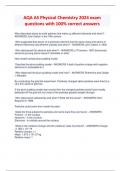
-
AQA AS Physical Chemistry 2024 exam questions with 100% correct answers
- Examen • 29 páginas • 2024
-
- $13.99
- + aprende más y mejor
AQA AS Physical Chemistry 2024 exam questions with 100% correct answers Who described atoms as solid spheres that make up different elements and when? - ANSWERS John Dalton in the 19th century Who suggested that atoms of a particular element had the same mass and atoms of different elements had different masses and when? - ANSWERS John Dalton in 1803 Who discovered the electron and when? - ANSWERS JJ Thomson, 1897 discovered electrons proving atoms weren't indivisible or solid. New m...
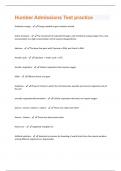
-
Humber Admissions Test practice Questions and Answers with complete solution
- Examen • 15 páginas • 2024
- Disponible en paquete
-
- $7.99
- + aprende más y mejor
Activation energy - Energy needed to get a reaction started Active transport - The movement of materials through a cell membrane using energy; from a low concentration to a high concentration until it reaches disequilibrium. Adenine - The base that pairs with Thymine in DNA, and Uracil in RNA Aerobic cycle - Glycolysis -> Kreb's cycle -> ETC Aerobic respiration - Cellular respiration that requires oxygen Allele - Different forms of a gene Anaphase - Phase of mitosis in which the ch...

-
DAT General Chemistry Exam Solution.
- Examen • 16 páginas • 2024
-
Disponible en paquete
-
- $12.99
- + aprende más y mejor
Atomic Number - correct answer number of protons found in that atom; low number; (Z) Mass Number - correct answer Protons + Neutrons; high number; (A) Atomic Mass - correct answer relative mass of that atom compared to the mass of a carbon-12 atom (which is set at 12.00); measured in amu; 1 amu = - correct answer 1.66x10^-24 Atomic Weight - correct answer weight (g) of one mole (mol) of a given element (g/mol); the weighted average of all the masses (not the weights) of an element, w...
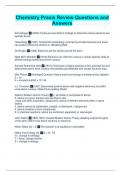
-
Chemistry Praxis Review Questions and Answers
- Examen • 23 páginas • 2024
-
- $9.49
- + aprende más y mejor
Schrodinger (1925) Continued upon Bohr's findings to determine where electrons are typically found. Heisenberg (1927) Created the heisenberg uncertainty principle because you never can predict where the electron is. (Breaking Bad) De Broglie (1924) Electrons act like waves around the atom. Niels Bohr (Bohrbit) (1913) Electrons can orbit the nucleus in certain special orbits at different energy levels around the nucleus. Earnest Rutherford (foil) (1910) Fired beam of alpha particles ...
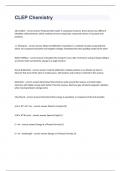
-
CLEP Chemistry Review Practice Questions 2024.
- Examen • 15 páginas • 2024
-
Disponible en paquete
-
- $11.49
- + aprende más y mejor
CLEP Chemistry Review Practice Questions 2024. John Dalton - correct answer Proposed that matter is composed of atoms; these atoms have different identities called elements, which combine to form compounds; measured masses of reactants and products. J.J. Thompson - correct answer Observed deflection of particles in a cathode ray tube; proposed that atoms are composed of positive and negative charges; developed the plum pudding model of the atom Robert Millikan - correct answer Calculated ...
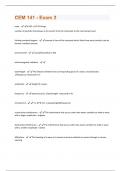
-
CEM 141 - Exam 2 Questions And Answers Rated A+ New Update Assured Satisfaction
- Examen • 8 páginas • 2024
- Disponible en paquete
-
- $7.99
- + aprende más y mejor
mole - 6.022 x 10^23 things number of particles that allows us to convert from the molecular to the macroscopic level limiting reactant/reagent - amount of one of the reactants which limits how much product can be formed. smallest amount. percent yield - actual/theoretical x 100 electromagnetic radiation - wavelength - The distance between two corresponding parts of a wave. seconds/wave. 1/frequency. measured in m amplitude - Height of a wave frequency - waves/second. 1/wavelength. meas...
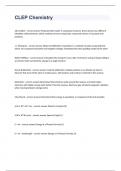
-
CLEP Chemistry questions well answwred graded A+ 2023
- Examen • 15 páginas • 2023
- Disponible en paquete
-
- $15.49
- + aprende más y mejor
CLEP ChemistryJohn Dalton - correct answer Proposed that matter is composed of atoms; these atoms have different identities called elements, which combine to form compounds; measured masses of reactants and products. J.J. Thompson - correct answer Observed deflection of particles in a cathode ray tube; proposed that atoms are composed of positive and negative charges; developed the plum pudding model of the atom Robert Millikan - correct answer Calculated the charge-to-mass ratio of electr...
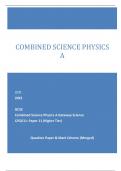
-
OCR 2023 GCSE Combined Science Physics A Gateway Science J250/11: Paper 11 (Higher Tier) Question Paper & Mark Scheme (Merged)
- Examen • 47 páginas • 2024
-
- $8.49
- + aprende más y mejor
2 © OCR 2023 Section A You should spend a maximum of 20 minutes on this section. Write your answer to each question in the box provided. 1 Which new feature of the atomic model did Niels Bohr suggest? A Electrons are in stable shells. B Electrons orbit a nucleus. C The atom has a nucleus. D The nucleus is positive. Your answer [1] 2 Two rooms have the same fixed volume. They contain identical gases at the same pressure. Room H is at a higher temperature than room L. Which statement...

¿Estrés por los estudios? Para los vendedores en Stuvia, estos son tiempos de oro. ¡KA-CHING! Gana también con tus resúmenes y empieza a subirlos ya. Descubre todo sobre cómo ganar en Stuvia


